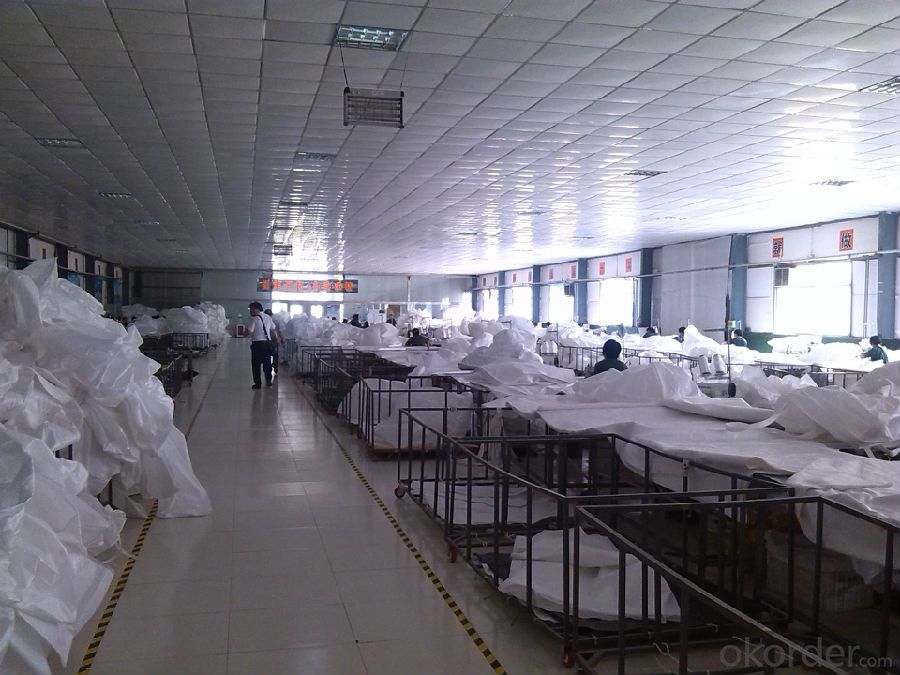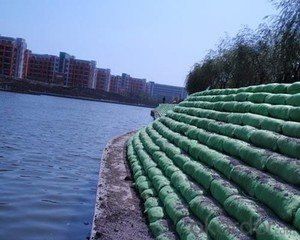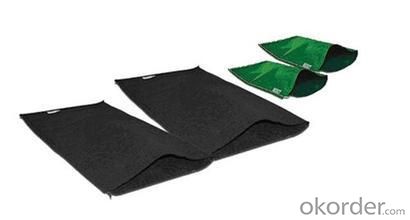Ecological Geo Bag with CE certification
- Loading Port:
- Qingdao
- Payment Terms:
- TT OR LC
- Min Order Qty:
- 30000 pc
- Supply Capability:
- 500000 pc/month
OKorder Service Pledge
OKorder Financial Service
You Might Also Like
Description Of Ecological Geo Bag
Eco bag material is a kind of non woven geotechnical fabric, It is made of polypropylene (PP) or polyester fiber (PET) is made of raw materials or single-sided double-sided ironing needling non-woven fabrics processed bag.
Main Features of Ecological Geo Bag
1. On both sides of the river: Natural bank with the environment of human and wildlife coexistence
2. Green mine recovery: Comprehensive utilization of mine gangue, scientific renovation subsidence area, greening of barren hills, purifying water, create the mine ecological restoration, barren hills and green complex in New Era
3. The lake shore, the sea surface landslide, culvert hole, a drainage ditch, soil erosion, irrigation system
4. Artificial wetland: Ecological restoration
5. Roof greenin
Specifications of Ecological Geo Bag
| No. | Specification(g/m2) | 100 | 150 | 200 | 250 | 300 | 350 | 400 | 450 | 500 | 600 | 700 | 800 | 1000 | Remark |
| 1 | Weight deviation, % | -8 | -8 | -8 | -8 | -7 | -7 | -7 | -7 | -6 | -6 | -6 | -6 | -6 | |
| 2 | Thickness, mm≥ | 0.9 | 1.3 | 1.7 | 2.1 | 2.4 | 2.7 | 3 | 3.3 | 3.6 | 4.1 | 4.5 | 5 | 5.8 | |
| 3 | Width deviation,% | -0.5 | |||||||||||||
| 4 | Breaking strength, KN/m ≥ | 2.5 | 4.5 | 6.5 | 8 | 9.5 | 11 | 12.5 | 14 | 16 | 19 | 22 | 25 | 31 | MD and CD |
| 5 | Breaking elongation,% | 25~100 | |||||||||||||
| 6 | CBR bursting strength, KN≥ | 0.3 | 0.6 | 0.9 | 1.2 | 1.5 | 1.8 | 2.1 | 2.4 | 2.7 | 3.2 | 3.7 | 4 | 5 | |
| 7 | Sieve Size O90 mm | 0.07~0.2 | |||||||||||||
| 8 | Vertical permeability | Kx(10-1~10-3 ) | K=1.0 ~9.9 | ||||||||||||
| coefficient, cm/s | |||||||||||||||
| 9 | Tear strength, KN≥ | 0.08 | 0.12 | 0.16 | 0.2 | 0.24 | 0.28 | 0.33 | 0.38 | 0.42 | 0.46 | 0.53 | 0.6 | 0.75 | MD and CD |
Ecological Geo Bag Images




FAQ
1. Do you supply free samples for customers?
Yes,we will supply free samples for you.Please send your address for us.
2. How Many years experience do you have?
We have been exported to more than 20 countries in the past 15 years.
3. How long do we usually reply your request?
We always reply our customer within 24 hours.
- Q:What are the different installation guidelines for geotextiles in reinforcement projects?
- The installation guidelines for geotextiles in reinforcement projects typically involve the following steps: 1. Site Preparation: Clear the construction area of any vegetation, debris, or loose soil. Level the ground and remove any protrusions or sharp objects that could damage the geotextile. 2. Geotextile Placement: Unroll the geotextile over the prepared area, ensuring it covers the entire project site. Overlaps between adjacent rolls should be at least 1 to 2 feet to provide proper continuity. 3. Anchoring: Secure the geotextile at the edges using anchor trenches, stakes, or other appropriate methods to prevent movement during installation or in the long term. 4. Jointing: Overlap adjacent geotextile panels by a minimum of 1 to 2 feet, depending on the project requirements. Secure the overlap with appropriate fasteners or adhesives to ensure proper functioning. 5. Protection: If necessary, cover the geotextile with a protective layer, such as a layer of soil or aggregate, to shield it from potential damage during construction activities or exposure to UV radiation. 6. Compaction: If the project involves soil stabilization or reinforcement, follow the recommended compaction procedures to ensure proper integration of the geotextile with the surrounding soil or aggregate. 7. Quality Control: Regularly inspect the geotextile installation to ensure that it is properly placed, free of damage, and functioning as intended. Any identified issues should be addressed promptly. It is important to note that specific installation guidelines may vary depending on the project type, site conditions, and the type of geotextile being used. It is recommended to consult the manufacturer's recommendations and seek professional guidance to ensure proper installation.
- Q:How do geotextiles help in preventing soil erosion in agricultural fields?
- Geotextiles help in preventing soil erosion in agricultural fields by acting as a barrier between the soil and external forces such as wind and water. They stabilize the soil by reducing surface runoff, preventing sedimentation, and promoting the growth of vegetation. Geotextiles also enhance filtration and drainage, allowing water to flow through while retaining soil particles, thus minimizing the risk of erosion.
- Q:Are geotextiles resistant to extreme weather conditions?
- Yes, geotextiles are designed to be resistant to extreme weather conditions. They are manufactured using high-quality materials that can withstand harsh weather elements such as heavy rains, strong winds, and intense sunlight. Geotextiles are specifically engineered to provide long-lasting performance and durability even in extreme weather conditions.
- Q:How do geotextiles help with reinforcement of geogrid reinforced walls?
- Geotextiles help with the reinforcement of geogrid reinforced walls by acting as a separation layer between the soil and the geogrid. They prevent the intermixing of soil particles and the geogrid, maintaining the integrity and effectiveness of the reinforcement system. Additionally, geotextiles also aid in the filtration of water, preventing the clogging of the geogrid and ensuring proper drainage. Overall, geotextiles enhance the stability and longevity of geogrid reinforced walls by providing essential separation and filtration functions.
- Q:What are the key factors affecting the filtration performance of geotextiles?
- The key factors affecting the filtration performance of geotextiles include the pore size and distribution of the fabric, the thickness and permeability of the material, the hydraulic gradient or pressure difference across the geotextile, and the presence of any clogging or blockage due to soil particles. Other factors such as the type of soil, the duration of filtration, and the geotextile's chemical and physical properties can also influence its performance.
- Q:What is the role of geotextiles in geotechnical engineering?
- The role of geotextiles in geotechnical engineering is to provide reinforcement, separation, filtration, and drainage in construction projects. They are used to enhance the stability and performance of soil or other materials by acting as a barrier, preventing the intermixing of different layers, facilitating water movement, and distributing loads. Geotextiles are commonly employed in road construction, embankments, retaining walls, erosion control, and landfills to improve the overall geotechnical characteristics of the project.
- Q:How do geotextiles help with filtration in drainage systems?
- Geotextiles help with filtration in drainage systems by acting as a barrier that prevents the passage of fine particles while allowing water to pass through. They effectively filter out sediment, debris, and other contaminants, ensuring that only clean water flows through the drainage system. This helps to maintain the system's functionality and prevent clogging or blockages.
- Q:Geotextile cloth can be set what amount of emergency!
- Construction, municipal quota can be.
- Q:Are geotextiles environmentally friendly?
- Yes, geotextiles can be considered environmentally friendly. Geotextiles are designed to have minimal impact on the environment and can be made from recycled materials. They can help with erosion control, soil stabilization, and filtration, reducing the need for harmful chemicals or excessive soil excavation. Additionally, geotextiles are often biodegradable or can be recycled at the end of their lifespan, further contributing to their environmental friendliness.
1. Manufacturer Overview |
|
|---|---|
| Location | |
| Year Established | |
| Annual Output Value | |
| Main Markets | |
| Company Certifications | |
2. Manufacturer Certificates |
|
|---|---|
| a) Certification Name | |
| Range | |
| Reference | |
| Validity Period | |
3. Manufacturer Capability |
|
|---|---|
| a)Trade Capacity | |
| Nearest Port | |
| Export Percentage | |
| No.of Employees in Trade Department | |
| Language Spoken: | |
| b)Factory Information | |
| Factory Size: | |
| No. of Production Lines | |
| Contract Manufacturing | |
| Product Price Range | |
Send your message to us
Ecological Geo Bag with CE certification
- Loading Port:
- Qingdao
- Payment Terms:
- TT OR LC
- Min Order Qty:
- 30000 pc
- Supply Capability:
- 500000 pc/month
OKorder Service Pledge
OKorder Financial Service
Similar products
New products
Hot products
Related keywords

































